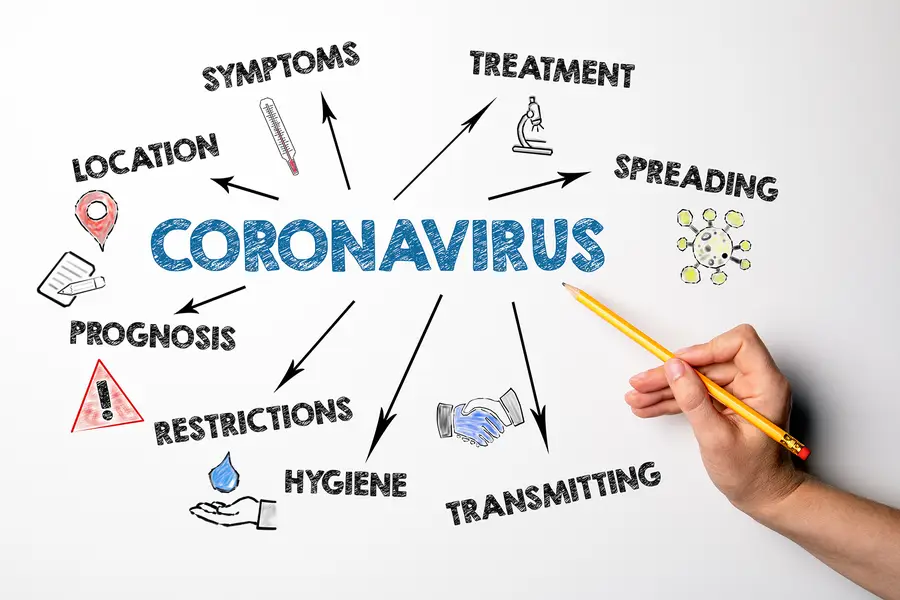
The world is grappling with the spread of COVID-19, a disease caused by a novel coronavirus. In the midst of the crisis, RTI infectious disease epidemiologist Pia MacDonald spoke at the Spring Annual Meeting of the American College of Trial Lawyers, comparing the COVID-19 situation to other outbreaks in history, and addressing the public health system’s ability to manage the situation. This Q&A is based on her talk.
What are the origins of COVID-19?
Coronavirus disease 2019, now known as COVID-19, is a zoonotic disease. Zoonotic diseases are caused by pathogens (or germs) that spread between animals and people. When pathogen spread occurs between animals and people, it is considered a spillover event.
These events become especially noteworthy and concerning when there is sustained transmission of the spillover pathogen from person to person. Some other zoonotic diseases and pathogens you may know of include Ebola, anthrax, plague, hantavirus, and influenza.
Coronaviruses are a large family of viruses that exist around the world. Some circulate and cause illness in people and others usually only infect animals. For example, coronaviruses cause between 10 and 30 percent of common colds in people.
How does COVID-19 compare to other infectious diseases in history?
The virus that causes COVID-19 is the third dangerous coronavirus to make the leap from animals to humans in recent memory. Severe Acute Respiratory Syndrome, or SARS, emerged in 2002 before disappearing after the first outbreak (2002-2004). In 2012 we saw the emergence of Middle Eastern Respiratory Syndrome, or MERS, which is still causing sporadic outbreaks.
SARS and MERS have case fatality rates of 9 percent and 34 percent, respectively. The case fatality rate, a measure of disease severity, is the proportion of reported cases of a specified disease or condition which are fatal within a specified time. Based on available data, the recent World Health Organization (WHO) case fatality rate estimate for COVID-19 is 3.4 percent globally.
Despite the unknowns and likely variability in case fatality rates across settings, we do know that some people are at higher risk of getting very sick from COVID-19, including older adults and people who are immunocompromised or have serious chronic medical conditions like heart disease, diabetes, and lung disease.
Let’s look at other diseases, such as colds, flu, and measles to compare. There are two variables to consider: the case fatality rate and the average number of people that each sick person will infect.
At one extreme, you have the common cold and the 2009 “swine flu.” These have a case fatality rate below 0.1 percent, and infected people usually transmit the disease on to only one or two others.
Measles has a relatively low case fatality rate, but because the virus can remain suspended in the air for quite some time, it is highly transmissible. One person with measles infects 15 others, on average. Measles outbreaks grow extremely fast for this reason.
MERS has a case fatality rate of 34 percent, and the average number of people each sick person infects is less than one. These characteristics have kept MERS from growing into larger outbreaks.
The data are showing that COVID-19 case fatality rates fall somewhere between the Spanish flu of 1918 and polio. According to the latest estimates, each person with COVID-19 transmits the disease to 2.3 people, mostly within their own household. As it spreads and more people are tested, the 3.4 percent fatality rate is likely to change. It may also vary based on the health system and infrastructure.
How does COVID-19 spread?
The virus that causes COVID-19 is thought to spread primarily through droplets that are released when sick people cough and/or sneeze. This means that close contact with a sick person raises the risk of infection. Having a sick person wear, and frequently change, a surgical face mask to catch droplets is one way to reduce the chance of transmission.
In the areas of China where this disease first appeared, the virus that causes COVID-19 spread mostly within homes, because people are in close, sustained contact. Based on preliminary reports, in China, transmission in airports, planes, trains, streets, even hospitals was not the primary driver of the outbreak growing.
What are the global implications of COVID-19?
The good news from China is that, as of early March, the outbreak there seems to be waning. This means that with each day, there are fewer and fewer people with infections. China’s ambitious, agile, aggressive containment effort is the largest in history, and it offers lessons for the rest of the world as we confront this epidemic.
Not all countries can take such decisive measures. In fact, only one third of countries currently have the capacity to quickly detect and report diseases that could pose an international threat. What happens if another epidemic breaks out in one of those countries, like the West African Ebola virus disease outbreak that began in Guinea in late 2013?
COVID-19 has already reached pandemic proportions. In the United States, the first reported COVID-19 cases were among persons who had recently traveled to China. Quickly, however, the disease began spreading in communities throughout the country. The public health response is accelerating as well. Many laboratories outside of the CDC in Atlanta have gained the ability to test for COVID-19, and work on a vaccine is moving quickly.
But diagnostic tests and vaccines aren’t the only tools relevant to this epidemic. Supportive care and treatment are also important for those people with severe infection. New therapeutics to treat people with COVID-19 are being developed and tested. However, alarmingly, China and India produce approximately 80 percent of active ingredients for pharmaceuticals. Any disruption in the supply chain for pharmaceuticals could limit our ability to treat patients.
Are we prepared for this outbreak, or for future outbreaks?
In a word, no. This is true here in the U.S. and globally. We already expect the world population to double in the next 40 years. Some of the fastest-growing areas are also at the highest risk of zoonotic disease outbreaks.
By 2050, two-thirds of the world will live in megacities—cities of more than 10 million people. It’s unlikely that our infrastructure can keep up with that kind of growth, meaning we will see crowding and inadequate sanitation. Weaker public health systems, like those in low- and middle-income countries, will have the hardest time keeping up.
Now is the time to advocate fiercely for public health preparedness and global health security funding. There’s a saying that parents are only as happy as their least happy child. From a global health security perspective, you could say that the whole world is only as safe as our least safe country.
Because we don’t have data on where we really are in terms of the outbreak, our response is like throwing darts on a dartboard that we cannot see. What will be most effective? Very difficult to know, but our societal immediate challenge and focus should be on keeping the most vulnerable safe. There is clarity from the epidemiological data on who is most at risk. It’s clearly dependent on age and underlying health status.
